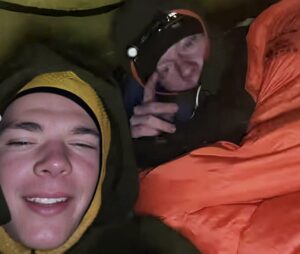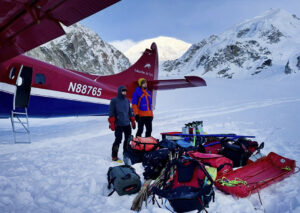Two difficult but successful rescues have occurred around Denali, as climbing season is underway on North America’s highest peak.
One Japanese mountaineer suffered severe injuries in a major fall and required a life flight. A day later, another team climbing the West Face of nearby Peak 11,300 became stranded after losing critical gear. Denali National Park Service (NPS) Mountaineering Rangers rescued them by helicopter after a night of exposure.
Here’s what we know.
Japanese climber falls 300m
At 2 am on May 20, rangers received a call from a climber who had watched their partner fall out of sight on the West Face of Denali. The fallen climber, 24-year-old Tatsuto Hatanaka, had disappeared from just above a fixed line at 4,930 meters around 11 pm.
Rangers scrambled to the scene in an NPS helicopter. They located Hatanaka, 300 meters below his fall point on the Peters Glacier. But they couldn’t access him due to thick cloud cover, according to an NPS press release.
More rangers were dispatched from Camp 3 (4,328m), several hundred meters below where Hatanaka lay. Hoping to guide the NPS’ high-altitude helicopter in, the Alaska Rescue Coordination Center (ARCC) sent a C-130 military transport plane to seek out holes in the surrounding cloud ceiling.
Finally, the NPS said, a Life Med helicopter transported Hatanaka to a hospital. Denali Mountaineering public information officer Maureen Gualtieri said she “understands” he was still hospitalized as of Wednesday.
Tenuous rescue on Peak 11,300
Separately, ARCC received another call Saturday evening, just hours after beginning Hatanaka’s rescue.
According to an InReach notification, two climbers were stranded on Peak 11,300 (named for its elevation in feet) on the West Fork of the Ruth Glacier.
They were suffering from minor injuries, stuck due to lost gear and “damaged ropes,” the NPS said. Gualtieri said a fall caused their injuries, which included cuts, abrasion, and swelling.
“The rescue was less about any medical intervention, but more about the fact they were stranded in high-risk technical terrain without a rope or equipment to continue descending safely,” Gualtieri said in an email.
The climbers had to endure the night in their location. Deteriorating weather prevented any immediate rescue.
Conditions the next morning were flyable, though, and the helicopter took off into the Denali sky again at 9:15 am.
Rangers completed a “short-haul” rescue. As the helicopter hovered over the stranded climbers, one ranger lowered off on the end of a 75m line. With help from a spotter, the pilot guided the dangling ranger to the climbers. The rescuer secured the climbers to the line, and the helicopter proceeded to a nearby staging area.
The group jumped inside and flew to safety in Talkeetna.
Conditions ‘return to normal’
Gualtieri said snow and weather conditions around Denali are average for this time of year, according to a longtime ranger who’d just come off a multi-week patrol.
Flying conditions have returned to normal after an especially fraught season last year, and glacier travel is “always potentially dicey,” she said.
Climbers will continue to flock to Denali in the coming weeks. Notably, prominent ultrarunner Jack Kuenzle (who last year broke Kilian Jornet’s record on the Bob Graham round) has been staging in Talkeetna since yesterday.






